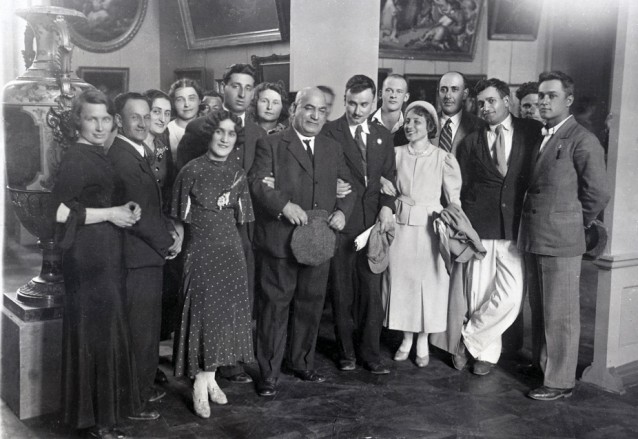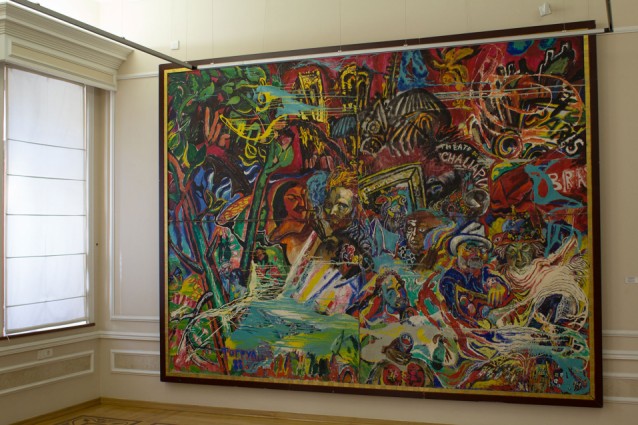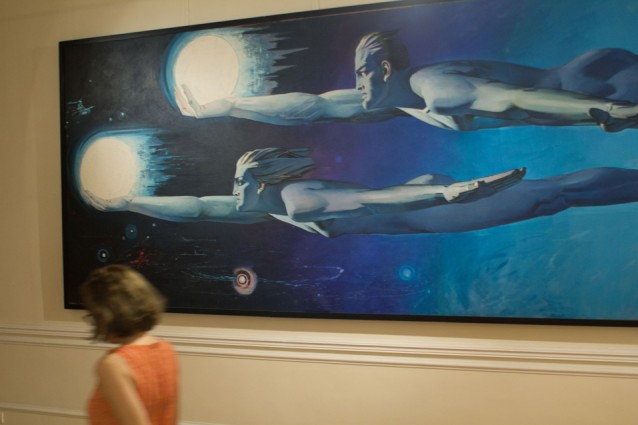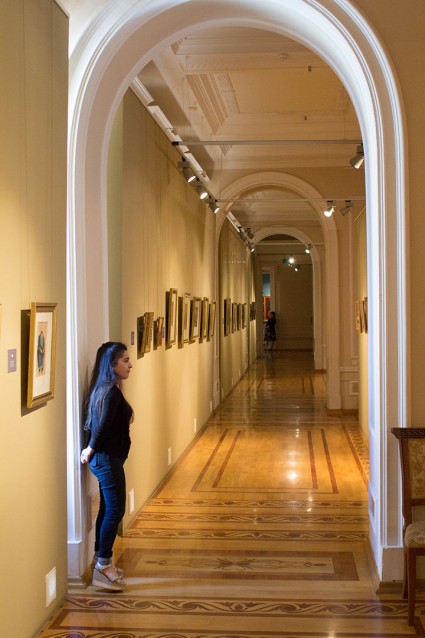The Azerbaijan National Museum of Art is the largest art museum in Azerbaijan. Named after scenic designer and theatre artist Rustam Mustafayev, it currently comprises two conjoined buildings. Its collection includes over 15,000 artworks, of which more than 3,000 are permanently displayed in around 60 rooms, the earliest of which dates back to the 4th century BC. In 2001, the museum was declared to be of National and then of European Museum Standard (EMS), and was completely reconstructed in 2006. As the museum celebrates the 80th anniversary of its first exhibition this year, Neil Watson caught up with Professor Chingiz Farzaliyev, Director of the Azerbaijan National Museum of Art.
VoA – What led to the establishment of the Azerbaijan National Museum of Art in 1936?
CF – Azerbaijanis have always been fond of art and culture and have a tradition of collecting beautiful artworks. During the first Azerbaijani oil boom at the end of the 19th and beginning of the 20th century, the first Bakuvian oil millionaires were purchasing expensive artworks from across Europe and Russia for their personal collections. During the Soviet period, the pearls of these collections were transferred to the newly created Azerbaijani State Museum.
In addition to artworks, many items of ethnographic or historical interest were collected. This justified the need to establish a separate museum, solely devoted to culture and art. The Art Department was separated from the Azerbaijani State Museum. This was established as an independent art museum under a state decree, signed on 31 March 1936, with the first exhibition opening the following year. Even at this nascent stage, it already contained more than 500 sculptures, paintings and other pieces from the 19th and 20th centuries, brought from the Netherlands, Belgium, France, Germany, Russia and other countries.
From its inception, the museum received state support. Furthermore, the buildings in which our museum is currently located are significant examples of Bakuvian architecture. Following the passing of a State Decree in 1951, the Baroque-style De Bour mansion became the main location for the Azerbaijani National Museum of Art. In 1992, the museum was granted another neighbouring building, which was formerly the Mariinsky Gymnasium for Girls and later the headquarters of the Baku branch of the Azerbaijani Communist Party. In 2013, the two buildings were connected, thereby becoming one complex.
From where do the museum collections originate?
As previously mentioned, many items originated in the personal collections of Bakuvian oil millionaires during the early 20th century. Later, as part of a plan to further develop the museum collection, some exhibits were received as gifts from the Hermitage Museum and State Russian Museums in St Petersburg, the Tretyakov State Gallery in Moscow, The Pushkin State Museum of Fine Arts in Moscow and numerous other Eastern and Chinese museums. Simultaneously, pieces of Azerbaijani decorative applied and visual arts were added. During visits to various regions of Azerbaijan, experts further augmented the collection with additional artefacts, and continue to do so to this day. The works of Azerbaijani painters, and gifts from famous Azerbaijani and foreign artists, have further developed our collections.
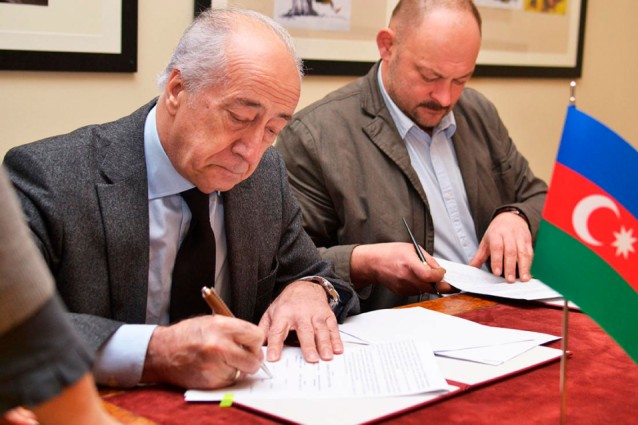 Professor Chingiz Farzaliyev, Director, Azerbaijan National Museum of Art signs a protocol with Professor Dmitriy Stus, Director, Belarusian National Arts Museum
Professor Chingiz Farzaliyev, Director, Azerbaijan National Museum of Art signs a protocol with Professor Dmitriy Stus, Director, Belarusian National Arts Museum
Which artworks by famous Azerbaijani painters are included in the collection?
The Azerbaijani National Museum of Art contains the richest and most varied collection of Azerbaijani art in the country, including works by the foremost Azerbaijani painters from across the centuries. I can proudly say that our museum is able to present the highest level of Azerbaijani art for local and international visitors.
The museum is currently undergoing extensive reconstruction work, and entrance to all our exhibitions, including those of Azerbaijani art, is now fully or partially restricted. I hope these works will soon be concluded, thereby enabling more complete collections to be presented to art lovers.
Numerous 19th century artists are represented in our collection, including Mir-Mohsun Navvab (1833–1918), who spent his entire life in Shusha, now located in Armenian-occupied Nagorno-Karabakh; Mirza Kadym Irevani (1825–75), the founder of Azerbaijani panel painting, who was also an ornamentalist and portraitist; and ornamentalist Usta Gambar Karabakhi (c.1830–1905), also from Shusha, who was responsible for the incredible interior of the Khan’s Palace in Sheki.
We also have collections of major 20th century Azerbaijani artists, including Sattar Bahlulzade (1909–74), founder of contemporary Azerbaijani landscape painting; Tahir Salahov (b.1928), one of the leading exponents of the ‘severe style;’ Togrul Narimanbekov (1930–2013), who combined the abstract and figurative with national symbols; and Maral Rahmanzadeh (1916–2008), one of the most evocative Azerbaijani graphic artists.
Does the collection still contain examples of socialist realism from the Soviet period?
As in all Soviet Republics, socialist realism was the official and predominant style in Azerbaijan from the 1930s until the end of the 1980s. It is evident in the work of almost all Azerbaijani painters of that period, and we have retained such works in our museum. It can be seen not only in paintings, but also in ceramics, carpets, architecture, and carving. The works are well-executed and of high-quality, including the impressionistic work of Mikayil Abdullayev (1921–2002) and Nadir Abdurahmanov (b.1925), who created his own colourful style and worked extensively outside of Azerbaijan, providing unique perspectives on Iraq, Afghanistan and North Korea, amongst other countries.
Does your collection include Azerbaijani carpets?
Nowadays, there are now around 500 carpets in our collection, including those designed by such great artists as Latif Karimov and Kamil Aliyev, portrait carpet maker. Our collection includes examples from all the Azerbaijani carpet schools, including Qazakh, Quba, Shirvan, Baku, Ganja, Karabakh and Tabriz. In 2015, Sotheby’s in the UK showcased 17 carpets from our museum.
Altogether, there are more than 17,000 items in your collections. To which period do they belong?
There are two primary collections in the museum – Azerbaijani art and international art. As would be expected, the collection of national art is more ancient and rich, the oldest pieces dating from the Neolithic period. The collection also includes items from the Bronze Age.
We have ceramic pieces found in Nakhchivan, Mingachevir, Fuzuli, Sheki and Goygol, decorated with archaic figures, including candlesticks from the Salcuglu period; 13th century pieces from Bayil Castle; 16th century Korans; Eastern miniatures from the 17th and 18th centuries; metalwork from the 18th–20th centuries; silk and wooden artworks; national costumes; carpets and jewellery.
Furthermore, our collections include sculptures, paintings, graphic works and decorative applied artworks from Russia, Asia, Africa and Western Europe. This includes those by some of the foremost European engravers, Dutch and Flemish painters and many exhibits from Russian artists, including Wassily Kandinsky. Our ceramics collection is also unique, comprising pieces from 16th–20th century Italy, France, Germany and Japan, of similar quality to those in some of the world’s leading museums. There are also bronze, marble, granite and wooden sculptures from Western Europe, alongside those from the Near- and Middle East.
Which exhibitions are being organised at the present time?
We frequently undertake exhibitions to commemorate famous painters or historical events and have established a tradition of organising exhibitions on a national and international level. Over the past five years, we have organised more than 20 international exhibitions and have hosted exhibitions from numerous international museums and organisations.
For example, we have accommodated exhibitions from the Tretyakov State Gallery in Moscow, Victoria and Albert Museum in London, and many museums in Japan, China, Austria, and CIS countries. We aim to showcase works representing different periods, art movements, artists and their developments. In fact, such exhibitions serve to bind nations and people together, as real art has no borders and expresses an international language.
I would like to especially emphasise the successful exhibition of artworks, in 2012, lent by the Louvre Museum, Musée d’Orsay and the Pompidou Centre, amongst others, realised with the support of the Heydar Aliyev Foundation and TOTAL S.A., entitled French Pleasures – French Art and Culture from the Renaissance until today. Another joint event, organised in conjunction with the Yunus Emre Institute in 2013, was entitled Sultan of Sultans. In 2014, we organised the Saraku exhibition of modern Japanese painters, and in 2015 we hosted the Ways to Escape personal exhibition by the Iranian–Azerbaijani painter Akbar Behkalam.
We have also loaned our artworks to various international exhibitions and projects; in 2008, 2009 and 2016, some of our collection of works by Tahir Salahov were shown at the Belarusian National Arts Museum and the Tretyakov State Gallery in Moscow; our manuscripts from the Middle Ages were shown at the Vatican; and in 2015 we lent works to the Moscow-based exhibition We fight Nazism together, devoted to the 70th anniversary of victory in the Great Patriotic War. We also loaned works to the Azerbaijan Pavilion at the 56th Venice Biennale with the support of the Heydar Aliyev Foundation.
Did the presentation or selection of artworks change following the regaining of Azerbaijani independence in 1991?
Some changes have taken place, such as the presentation of approaches and art research in a less politically biased manner. We also specifically exhibited the artists whose work had fallen foul of the Soviet authorities, including Javad Mirjavadov (1923–92), Ashraf Murad (1925–79), Tofiq Javadov (1925–63), Kamal Ahmedov (1940–94) and others. Such artists have had an incredible impact on the history of Azerbaijani art. We also organised an exhibition entitled On the Crossroads of Centuries in 2011, which served to publicly present important works that had remained hidden in our museum archives. This included an exhibition devoted to Javad Mirjavadov, founder of the Azerbaijani avant-garde movement. Accompanied by dramatic lighting effects and soft national music, his works were exhibited in conjunction with ancient porcelain, weapons and metalwork.
Following the regaining of Azerbaijani independence, we started to further explore our historical and cultural heritage and present this in an easily accessible manner. The exhibition entitled Azerbaijan throughout the Millennium was inaugurated in 2013 and provides an invaluable chronological representation of Azerbaijani art, comprising many existing exhibits and new pieces. To organise this exhibition, museum experts visited all Azerbaijani regions to collect many interesting and valuable pieces. On 10 June 2011, the museum received National Museum status from the Azerbaijani government.
In the age of the internet and social media, how are you attracting the younger generation?
We have developed programmes for various age groups, designed to meet the interests of children. The main objective is to encourage children to visit museums, and to appreciate and understand the exhibits. We have been working on this for years and are trying to apply the experience of other museums across the world. We have already established a youth community, and encourage the exhibition of their works in the museum, to which they invite their classmates and parents. We also organise mobile exhibitions to some schools, and make visual presentations to engage more children.
Which events are being organised to commemorate the 80th anniversary of the museum?
This year, we are organising a number of international exhibitions, including exhibits drawn from our own collections. Exhibitions include those focusing on Flemish and French art, another exhibition being on the Sardar Castle of Bukan and its historic cultural environment, comprising pieces brought from the Georgian State Museum.
Naturally, exhibitions will form the core of the celebratory events, but we are also planning additional events. Throughout this 80th anniversary year, we are organising events, exhibitions, seminars, concerts, and publishing new books. All these serve to demonstrate the importance of our museum in the cultural and intellectual life of the Republic. Modern museums are not merely places where we keep ancient and valuable exhibits, but they serve to promote heritage, stimulate research and help Azerbaijanis and international visitors spend their free time in a worthwhile and educational manner.
Visit www.nationalmuseum.az for more information on the Azerbaijani National Museum of Art.
About the author: Neil Watson is the chief editor of TEAS Magazine.
